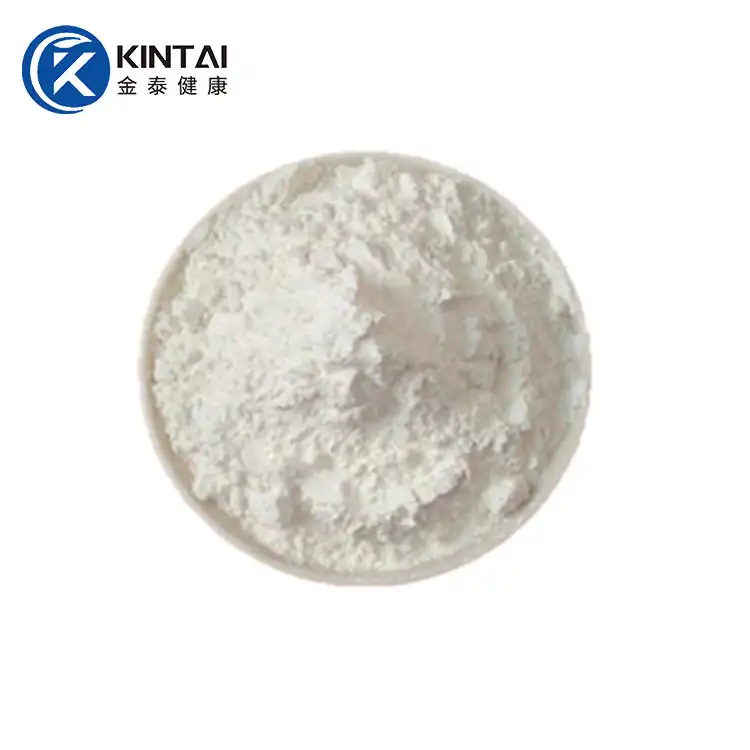Is Ferulic Acid The Same As Vitamin C?
2024-11-05 09:51:12
Natural Ferulic Acid and vitamin C are both powerful antioxidants that have gained significant attention in the skincare and health industries. However, they are distinct compounds with unique properties and benefits. While vitamin C is a well-known essential nutrient, ferulic acid is a plant-based compound that has been gaining popularity for its potential health and skincare benefits. In this blog post, we'll explore the differences between ferulic acid and vitamin C, their individual benefits, and how they can work together to enhance your skincare routine.

What are the main differences between ferulic acid and vitamin C?
Ferulic acid and vitamin C, while both antioxidants, have distinct chemical structures and origins. Vitamin C, also known as ascorbic acid, is a water-soluble vitamin that is essential for human health. It plays a crucial role in various bodily functions, including collagen synthesis, immune system support, and wound healing. On the other hand, ferulic acid is a hydroxycinnamic acid found in the cell walls of plants, particularly in seeds and leaves.
One of the key differences between ferulic acid and vitamin C lies in their stability. Vitamin C is notoriously unstable and can easily oxidize when exposed to air, light, or heat. This instability can reduce its effectiveness in skincare products and supplements. Ferulic acid, however, is more stable and can even help stabilize other antioxidants, including vitamin C.
Another significant difference is their primary sources. Vitamin C is found naturally in many fruits and vegetables, such as citrus fruits, strawberries, and bell peppers. It can also be synthesized for use in supplements and skincare products. Ferulic acid is primarily derived from plant sources, including rice bran, oats, and various fruits and vegetables.
In terms of their effects on the skin, both compounds offer antioxidant protection, but they work in slightly different ways. Vitamin C is known for its ability to brighten the skin, reduce hyperpigmentation, and stimulate collagen production. Ferulic acid, while also offering antioxidant benefits, is particularly effective at protecting the skin from environmental stressors and enhancing the efficacy of other antioxidants.
Despite these differences, Natural Ferulic Acid and vitamin C can complement each other when used together in skincare formulations. Their synergistic effects can provide enhanced protection against free radicals and improve overall skin health.

How does ferulic acid compare to vitamin C in skincare benefits?
When it comes to skincare benefits, both ferulic acid and vitamin C offer impressive results, but they excel in different areas. Vitamin C has long been a staple in skincare routines due to its ability to brighten the complexion, even out skin tone, and boost collagen production. It's particularly effective in reducing the appearance of dark spots and hyperpigmentation, making it a popular choice for those looking to achieve a more radiant complexion.
Vitamin C also plays a crucial role in protecting the skin from damage caused by UV radiation and environmental pollutants. Its antioxidant properties help neutralize free radicals, which can contribute to premature aging and skin damage. Additionally, vitamin C has been shown to enhance the skin's natural repair process, promoting faster healing of blemishes and wounds.
Ferulic acid, while less well-known than vitamin C, offers its own set of impressive skincare benefits. One of its standout features is its ability to enhance the stability and efficacy of other antioxidants, including vitamins C and E. This property makes ferulic acid an excellent addition to skincare formulations, as it can help prolong the shelf life and effectiveness of other active ingredients.
Like vitamin C, ferulic acid provides potent antioxidant protection against environmental stressors such as UV radiation and pollution. However, ferulic acid has been shown to be particularly effective in neutralizing free radicals generated by UVA and UVB rays, making it an excellent choice for sun protection when used in conjunction with sunscreen.
Ferulic acid also has anti-inflammatory properties, which can help soothe irritated skin and reduce redness. This makes it beneficial for those with sensitive or acne-prone skin. Furthermore, some studies suggest that ferulic acid may have a slight skin-firming effect, potentially helping to improve the appearance of fine lines and wrinkles.
While both compounds offer significant benefits, they work best when used together. The combination of Natural Ferulic Acid and vitamin C has been shown to provide superior antioxidant protection compared to either ingredient alone. This synergistic effect can result in improved overall skin health, enhanced protection against environmental damage, and more noticeable improvements in skin tone and texture.

Can ferulic acid and vitamin C be used together in skincare products?
Not only can ferulic acid and vitamin C be used together in skincare products, but their combination is often considered a powerhouse duo in the world of skincare. When formulated together, these two antioxidants work synergistically to enhance each other's benefits and provide superior protection for the skin.
One of the main advantages of combining ferulic acid and vitamin C is the increased stability of vitamin C. As mentioned earlier, vitamin C is notoriously unstable and can quickly oxidize when exposed to air, light, or heat. This oxidation can reduce its effectiveness and potentially lead to skin irritation. Ferulic acid, however, has been shown to help stabilize vitamin C, prolonging its efficacy and ensuring that it remains active in the skincare formulation for longer periods.
The combination of ferulic acid and vitamin C also provides enhanced antioxidant protection. While both ingredients are powerful antioxidants on their own, studies have shown that when used together, they can neutralize a broader spectrum of free radicals. This increased protection can help defend the skin against environmental stressors such as UV radiation, pollution, and other factors that contribute to premature aging.
Furthermore, the anti-inflammatory properties of ferulic acid can complement the potential irritation that some individuals may experience with high concentrations of vitamin C. This makes the combination particularly beneficial for those with sensitive skin who want to incorporate vitamin C into their skincare routine.
When looking for skincare products that combine ferulic acid and vitamin C, it's essential to pay attention to the formulation. Ideally, these ingredients should be present in a stable, water-free base to maximize their effectiveness. Serums are often the best vehicle for delivering these potent antioxidants, as they can penetrate the skin more easily than heavier creams or lotions.
It's also worth noting that while Natural Ferulic Acid and vitamin C work well together, they can also be used in conjunction with other antioxidants, such as vitamin E. This triple combination (vitamin C, vitamin E, and ferulic acid) has been shown to provide even greater antioxidant protection and skin benefits.
When incorporating products containing both ferulic acid and vitamin C into your skincare routine, it's generally recommended to use them in the morning. This allows the antioxidants to provide protection against environmental stressors throughout the day. However, always follow up with a broad-spectrum sunscreen, as these ingredients can increase skin sensitivity to UV radiation.
In conclusion, while ferulic acid and vitamin C are not the same, they complement each other beautifully in skincare formulations. Their combined use can provide enhanced antioxidant protection, improved stability of vitamin C, and a range of skin benefits from brightening to anti-aging effects. As with any new skincare product, it's always best to introduce it gradually and consult with a dermatologist if you have any concerns or specific skin conditions.

Kintai Healthtech Inc. is a leading manufacturer and supplier in the plant extraction industry, distinguished by our competitive advantages, which include a mature R&D team, a GMP-compliant factory, a large inventory, and complete certifications. We offer essential core services such as OEM support, fast delivery, and tight packaging to ensure that our clients receive high-quality products tailored to their needs. Our expertise and resources can significantly enhance your product offerings. For more details, please consult us at info@kintaibio.com. We look forward to the opportunity to work with you!
References:
- Lin, F. H., Lin, J. Y., Gupta, R. D., Tournas, J. A., Burch, J. A., Selim, M. A., ... & Pinnell, S. R. (2005). Ferulic acid stabilizes a solution of vitamins C and E and doubles its photoprotection of skin. Journal of Investigative Dermatology, 125(4), 826-832.
- Murray, J. C., Burch, J. A., Streilein, R. D., Iannacchione, M. A., Hall, R. P., & Pinnell, S. R. (2008). A topical antioxidant solution containing vitamins C and E stabilized by ferulic acid provides protection for human skin against damage caused by ultraviolet irradiation. Journal of the American Academy of Dermatology, 59(3), 418-425.
- Pullar, J. M., Carr, A. C., & Vissers, M. C. (2017). The roles of vitamin C in skin health. Nutrients, 9(8), 866.
- Zduńska, K., Dana, A., Kolodziejczak, A., & Rotsztejn, H. (2018). Antioxidant properties of ferulic acid and its possible application. Skin pharmacology and physiology, 31(6), 332-336.
- Telang, P. S. (2013). Vitamin C in dermatology. Indian dermatology online journal, 4(2), 143.
- Farris, P. K. (2005). Topical vitamin C: a useful agent for treating photoaging and other dermatologic conditions. Dermatologic surgery, 31, 814-818.
- Mancuso, C., & Santangelo, R. (2014). Ferulic acid: pharmacological and toxicological aspects. Food and Chemical Toxicology, 65, 185-195.
- Pinnell, S. R., Yang, H., Omar, M., Monteiro-Riviere, N., DeBuys, H. V., Walker, L. C., ... & Levine, M. (2001). Topical L-ascorbic acid: percutaneous absorption studies. Dermatologic surgery, 27(2), 137-142.
- Ganceviciene, R., Liakou, A. I., Theodoridis, A., Makrantonaki, E., & Zouboulis, C. C. (2012). Skin anti-aging strategies. Dermato-endocrinology, 4(3), 308-319.
- Mathew, S., & Abraham, T. E. (2004). Ferulic acid: an antioxidant found naturally in plant cell walls and feruloyl esterases involved in its release and their applications. Critical reviews in biotechnology, 24(2-3), 59-83.


_1759042872414.jpg)






